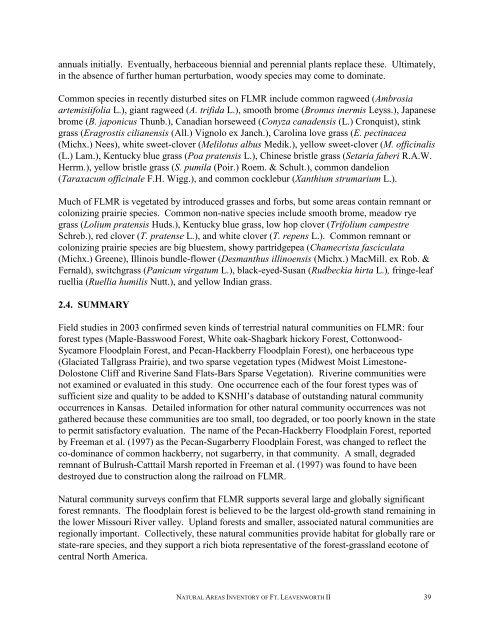A Natural Areas Inventory of the - Kansas Natural Heritage Inventory ...
A Natural Areas Inventory of the - Kansas Natural Heritage Inventory ...
A Natural Areas Inventory of the - Kansas Natural Heritage Inventory ...
Create successful ePaper yourself
Turn your PDF publications into a flip-book with our unique Google optimized e-Paper software.
annuals initially. Eventually, herbaceous biennial and perennial plants replace <strong>the</strong>se. Ultimately,<br />
in <strong>the</strong> absence <strong>of</strong> fur<strong>the</strong>r human perturbation, woody species may come to dominate.<br />
Common species in recently disturbed sites on FLMR include common ragweed (Ambrosia<br />
artemisiifolia L.), giant ragweed (A. trifida L.), smooth brome (Bromus inermis Leyss.), Japanese<br />
brome (B. japonicus Thunb.), Canadian horseweed (Conyza canadensis (L.) Cronquist), stink<br />
grass (Eragrostis cilianensis (All.) Vignolo ex Janch.), Carolina love grass (E. pectinacea<br />
(Michx.) Nees), white sweet-clover (Melilotus albus Medik.), yellow sweet-clover (M. <strong>of</strong>ficinalis<br />
(L.) Lam.), Kentucky blue grass (Poa pratensis L.), Chinese bristle grass (Setaria faberi R.A.W.<br />
Herrm.), yellow bristle grass (S. pumila (Poir.) Roem. & Schult.), common dandelion<br />
(Taraxacum <strong>of</strong>ficinale F.H. Wigg.), and common cocklebur (Xanthium strumarium L.).<br />
Much <strong>of</strong> FLMR is vegetated by introduced grasses and forbs, but some areas contain remnant or<br />
colonizing prairie species. Common non-native species include smooth brome, meadow rye<br />
grass (Lolium pratensis Huds.), Kentucky blue grass, low hop clover (Trifolium campestre<br />
Schreb.), red clover (T. pratense L.), and white clover (T. repens L.). Common remnant or<br />
colonizing prairie species are big bluestem, showy partridgepea (Chamecrista fasciculata<br />
(Michx.) Greene), Illinois bundle-flower (Desmanthus illinoensis (Michx.) MacMill. ex Rob. &<br />
Fernald), switchgrass (Panicum virgatum L.), black-eyed-Susan (Rudbeckia hirta L.), fringe-leaf<br />
ruellia (Ruellia humilis Nutt.), and yellow Indian grass.<br />
2.4. SUMMARY<br />
Field studies in 2003 confirmed seven kinds <strong>of</strong> terrestrial natural communities on FLMR: four<br />
forest types (Maple-Basswood Forest, White oak-Shagbark hickory Forest, Cottonwood-<br />
Sycamore Floodplain Forest, and Pecan-Hackberry Floodplain Forest), one herbaceous type<br />
(Glaciated Tallgrass Prairie), and two sparse vegetation types (Midwest Moist Limestone-<br />
Dolostone Cliff and Riverine Sand Flats-Bars Sparse Vegetation). Riverine communities were<br />
not examined or evaluated in this study. One occurrence each <strong>of</strong> <strong>the</strong> four forest types was <strong>of</strong><br />
sufficient size and quality to be added to KSNHI’s database <strong>of</strong> outstanding natural community<br />
occurrences in <strong>Kansas</strong>. Detailed information for o<strong>the</strong>r natural community occurrences was not<br />
ga<strong>the</strong>red because <strong>the</strong>se communities are too small, too degraded, or too poorly known in <strong>the</strong> state<br />
to permit satisfactory evaluation. The name <strong>of</strong> <strong>the</strong> Pecan-Hackberry Floodplain Forest, reported<br />
by Freeman et al. (1997) as <strong>the</strong> Pecan-Sugarberry Floodplain Forest, was changed to reflect <strong>the</strong><br />
co-dominance <strong>of</strong> common hackberry, not sugarberry, in that community. A small, degraded<br />
remnant <strong>of</strong> Bulrush-Catttail Marsh reported in Freeman et al. (1997) was found to have been<br />
destroyed due to construction along <strong>the</strong> railroad on FLMR.<br />
<strong>Natural</strong> community surveys confirm that FLMR supports several large and globally significant<br />
forest remnants. The floodplain forest is believed to be <strong>the</strong> largest old-growth stand remaining in<br />
<strong>the</strong> lower Missouri River valley. Upland forests and smaller, associated natural communities are<br />
regionally important. Collectively, <strong>the</strong>se natural communities provide habitat for globally rare or<br />
state-rare species, and <strong>the</strong>y support a rich biota representative <strong>of</strong> <strong>the</strong> forest-grassland ecotone <strong>of</strong><br />
central North America.<br />
NATURAL AREAS INVENTORY OF FT. LEAVENWORTH II 39


